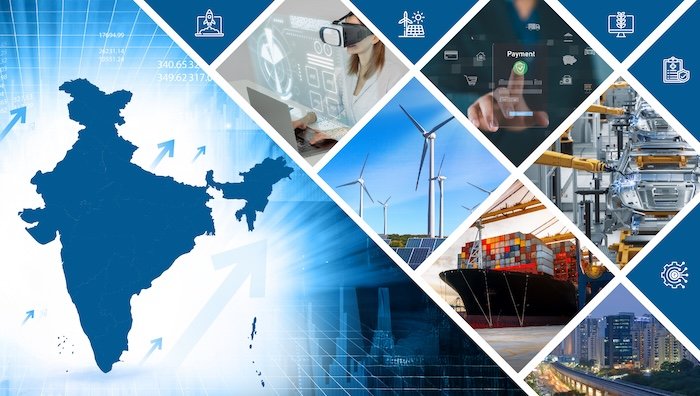A Bold Economic Vision for India
India’s growth journey has often been described as one of resilience, ambition, and transformation. Now, new projections suggest that by 2038, India could rise to become the world’s second-largest economy with a staggering GDP of $34.2 trillion. For a country that was once labeled as a developing nation, this forecast shines a light on how far India has come and how bright the road ahead looks.
Such a leap would mean India overtaking major global powers and positioning itself as a central force in shaping the global economy. This milestone would not only reflect numbers on a chart but would also highlight the determination of millions of Indians who are driving growth through innovation, entrepreneurship, and an unshakable spirit.
From Emerging Market to Economic Powerhouse
Over the past few decades, India has transitioned from being a largely agrarian economy to one that is powered by services, manufacturing, and technology. Liberalization reforms in the 1990s set the foundation, but it is the country’s youthful population, digital revolution, and policy-driven growth that are propelling it forward today.
With over 1.4 billion people, India’s demographic advantage is immense. More than half of its population is under the age of 30, creating a workforce that is not only vast but also increasingly skilled. This young, dynamic generation has become the backbone of industries ranging from information technology to manufacturing and global services.
The Technology and Innovation Edge
India’s digital transformation is perhaps the most striking element of its growth story. From mobile banking and e-commerce to digital governance and artificial intelligence, India is rapidly adopting technologies that improve efficiency and productivity.
The rise of homegrown tech startups, coupled with global investment, has created a thriving ecosystem of innovation. Cities like Bengaluru, Hyderabad, and Pune are no longer just regional hubs—they are now recognized globally as centers of talent and technological advancement.
This digital revolution has also empowered rural India, enabling farmers, small businesses, and remote communities to access financial services, education, and healthcare with just a smartphone. By 2038, this blend of technology and inclusivity is expected to be one of the key drivers behind India’s projected $34.2 trillion GDP.
Manufacturing and Infrastructure: Building the New India
While technology and services play a critical role, India’s manufacturing sector is also undergoing a major transformation. Government initiatives like “Make in India” and infrastructure expansion projects are laying the groundwork for India to become a global manufacturing hub.
From industrial corridors to smart cities, massive investments are being made to modernize India’s infrastructure. High-speed rail, renewable energy projects, and improved logistics are creating a foundation that will support long-term economic growth.
This expansion will not only generate millions of jobs but also make India a preferred destination for global companies seeking alternatives in their supply chains. By 2038, such developments could position India as both a production powerhouse and a consumption-driven market.
Rising Middle Class and Consumer Power
Another factor behind India’s projected economic rise is its rapidly growing middle class. As incomes rise and opportunities expand, millions of families are moving into the middle-income bracket. This shift is creating a surge in demand for everything from housing and automobiles to education and healthcare.
A stronger middle class means greater domestic consumption, which in turn drives industries to grow and expand. Unlike economies that depend heavily on exports, India’s internal demand provides stability and resilience, even during global uncertainties.
By 2038, this expanding consumer base is expected to make India one of the most lucrative markets for global and local businesses alike.
Challenges on the Road Ahead
While the projection of India becoming the second-largest economy by 2038 is inspiring, it does not come without challenges. The country still faces hurdles such as income inequality, unemployment, rural poverty, and climate-related concerns.
Balancing rapid industrialization with sustainability will be crucial. As the world shifts toward greener economies, India must ensure that its growth does not come at the cost of the environment. Additionally, reforms in education, healthcare, and governance will need to continue at an accelerated pace to support this growth trajectory.
Addressing these challenges effectively will determine whether India’s $34.2 trillion dream becomes a reality.

Global Implications of India’s Rise
India’s rise to the world’s second-largest economy would reshape global dynamics. It would give India a stronger voice in international trade, finance, and diplomacy. With a GDP of $34.2 trillion, India would be in a position to influence global markets, negotiate stronger trade agreements, and contribute significantly to global stability.
This growth would also strengthen India’s role in areas such as renewable energy, digital innovation, and healthcare. Its expertise and resources could help solve global challenges, from climate change to digital inclusion.
India’s Human Spirit: The True Driver of Growth
Beyond the numbers, the most inspiring part of India’s economic journey is its people. Farmers embracing technology, entrepreneurs turning small ideas into global businesses, students pushing boundaries in science, and workers building the nation’s infrastructure—every effort adds to the bigger picture.
The story of India’s rise is not just about GDP projections but about human ambition, resilience, and innovation. It is about a country that has faced adversity time and again but continues to move forward with hope and determination.
Looking Toward 2038
The vision of India becoming the world’s second-largest economy by 2038 is more than a report—it is a possibility that reflects the country’s growth momentum. With strong policies, technological innovation, and the unstoppable drive of its people, India has every chance of reaching that milestone.
If achieved, this would not only mark a turning point for India but also reshape the global economic order. The next 15 years could be the most transformative period in India’s history, and the world will be watching closely.
Read more- Trump’s Tariffs Can’t Shake India’s Growing Strength












Leave a comment